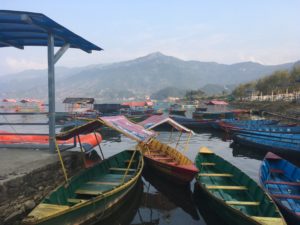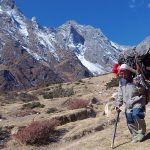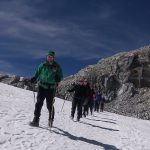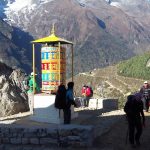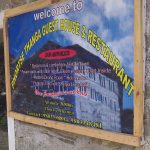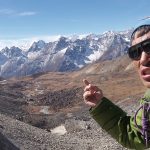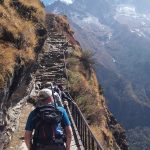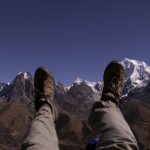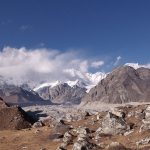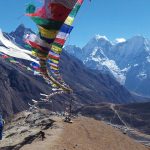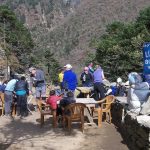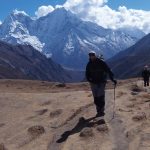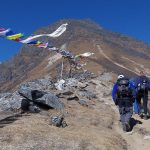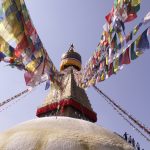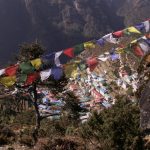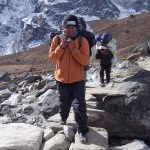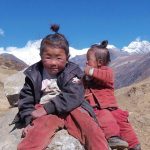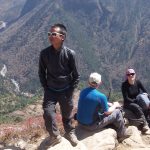Annapurna Discovery The Majestical Annapurna Sanctuary

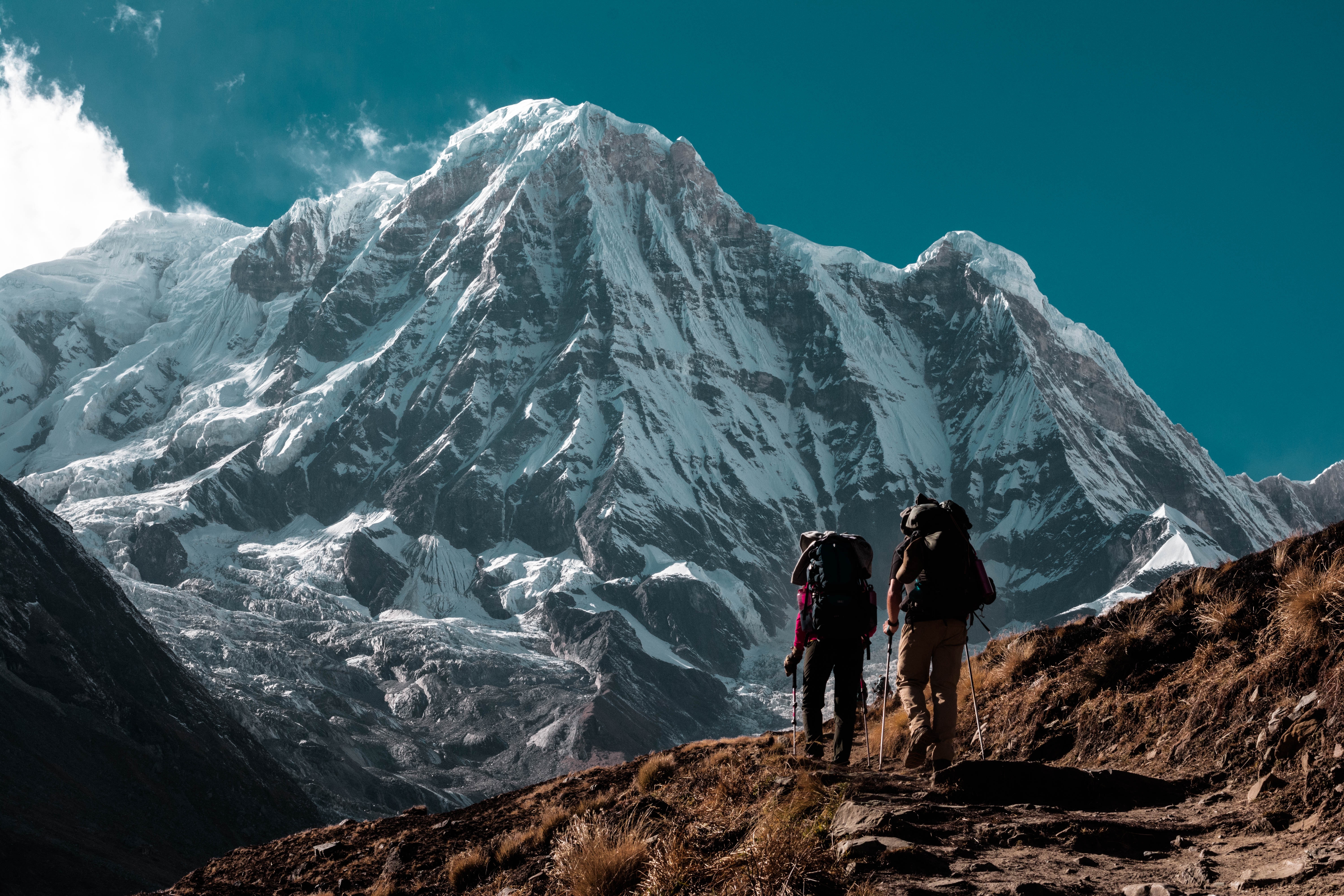
Why Choose Mountains in Mind?
- Excellent Sherpa conditions
- Supports the local community
- Small group sizes
- UK Guide
- Tailored itinerary
- Selective group dates
- Personal touch
- All inclusive price
- Deluxe accommodation
- Optional excursions
- GPS Trackers
-
On our trek to the Annapurna region of Nepal, you’ll have the opportunity to explore the contrasting scenic lakeside city of Pokhara after departing the colourful and vibrant city of Kathmandu.
Pokhara is overlooked by the sacred and enchanting Macchapuchhre Peak. Its striking, steep pyramidal peak resembles that of a fishtail for which it is commonly known. Alongside, Macchapuchhre, you’ll gaze in amazement at the magnificent Dhaulagiri and the stunning Annapurna both 7th and 10th highest mountains in the world respectively.
Our trek will take you into the heart of the Annapurna region, winding up through rhododendron forests and steep-sided gorges with awe-inspiring views to reach the wonderful glacial basin of the incredible Annapurna Sanctuary and Base Camp, where you’ll be surrounded by tall majestic peaks.
-
- Friday 4th October 2019 – Monday 21st October 2019
- £2845
- Other dates available. Contact us for details.
-
- International flights
- Internal flight to/from Pokhara
- All meals during the trek
- A welcome meal in Kathmandu
- Deluxe accommodation in Kathmandu and Pokhara
- Traditional guest house accommodation on the trek
- A fully supported Sherpa team with Nepali Sirdar
- Porters to carry your overnight baggage
- Full briefing on arrival
- Satellite phone
- Medical support
- Transfers to/from Kathmandu airport
- UK Expedition Leader
- All national park fees
- Online support and advice with your preparation
- Training plan to make the most of your trek (if required)
- A virtual get-together with a question and answer session
- Option to attend training weekend in the UK (at an additional cost)
- Plus dreams and friends to last a lifetime !!!
-
- Personal Insurance
- IMPORTANT. Confirm with your insurance provider that your policy covers you for trekking at altitude and includes emergency helicopter evacuation to Kathmandu.
- Visa (obtainable at Kathmandu airport)
- Lunch and evening meals in Kathmandu and Pokhara (apart from the initial welcome meal)
- Beverages
- Porter tips
- Additional excursions
- Personal Insurance
-
Friday 4th October
Depart the UK
Board your flight from Heathrow to Kathmandu.Saturday 5th OctoberArrive in Kathmandu
You will be greeted by our Nepalese representative on arrival at Kathmandu airport and transferred to the a high quality hotel in Kathmandu. There will be a trek briefing followed by the evening meal, where you can get to know your fellow adventurers on the trip.Accommodation: HotelMeals: DSunday 4th OctoberFly to PokharaYou will be transferred from the hotel to the airport for the short flight to Pokhara. At Pokhara, you’ll be met at the airport where you’ll be transferred to the hotel. You’ll have the rest of the day to yourself.Accommodation: HotelMeals: BMonday 5th OctoberDrive to Nayapul and trek to TirkhedungaYou’ll be driven to the trail head village of Nayapul and upon arrival you will be met by our amazing Sherpa/Porter team. After introductions, you’ll depart the village and trek towards your overnight destination at Tirkhedunga.Accommodation: LodgeMeals: B/L/DTime: 4-5 hoursTuesday 6th OctoberTrek to GhorepaniSurrounded by amazing views you’ll trek to the delightful village of Ghorepani with it’s distinctive blue roofed houses.Accommodation: LodgeMeals: B/L/DTime: 5-6 hoursWednesday 7th OctoberGhorepani to Tadapani via Poon HillRising before daybreak, you’ll trek the short distance in the dark to watch the magnificent sunrise over the Annapurna range from the summit of Poon Hill before continuing on your trek to the village of Tadapani.Accommodation: LodgeMeals: B/L/DTime: 6-7 hoursThursday 8th OctoberTadapani to ChomrungAfter a hearty breakfast, you’ll trek through the lush green valley crossing the Kimrong Khola river on an undulating path to join the Modi Khola valley to arrive at your overnight destination at Chomrung.Accommodation: LodgeMeals: B/L/DTime: 5-6 hoursFriday 9th OctoberChomrung to DovanYou’ll trek above the Modi Khola river through bamboo, rhododendron and oak forest with spectacular views up the valley to arrive through the village of Bamboo and onto the village of Dovan.Accommodation: LodgeMeals: B/L/DTime: 6-7 hoursSaturday 10th OctoberDovan to Macchapuchhare Base CampYou’ll continue up the valley passing several by several Stupa’s and through the village of Deurali to arrive at the head of the valley and base of the sacred and awe-inspiring Fishtail mountain, Macchapuchhare.Accommodation: LodgeMeals: B/L/DTime: 6-7 hoursSunday 11th OctoberMacchapuchhare to Annapurna Base CampYou’ll head into the wonderful Annapurna Sanctuary, the natural amphitheatre surrounded by the majestic peaks of Annapurna 1 and 2, where you’ll see the South Annapurna Glacier to arrive at Annapurna Base Camp.Accommodation: LodgeMeals: B/L/DTime: 3-4 hoursMonday 12th OctoberAnnapurna Base Camp to BambooYou’ll retrace your steps back along the Modi Khola river and stay overnight in the village of Bamboo.Accommodation: LodgeMeals: B/L/DTime: 6-7 hoursTuesday 13th OctoberBamboo to Jhinu DandaYou’ll continue to head out of the valley with fantastic scenery all around and will arrive at the village of Jhinu Danda, famed for its hot springs. You’ll have the opportunity to bath in the springs to rejuvenate your weary muscles.Accommodation: LodgeMeals: B/L/DTime: 5-6 hoursWednesday 14th OctoberJhinu Danda to Thulo KharkaYou’ll follow an undulating trail through rhododendron forests passing through several villages and over a several suspension bridges on the way to stay in the picturesque village of Thulo Kharka (Australian Camp) overnight.Accommodation: LodgeMeals: B/L/DTime: 5-6 hoursWednesday 15th OctoberThulo Kharka to KandeA shorter trek today will take you to the trailhead village of Kande. You’ll sadly say goodbye to the porters and you’ll be met by our driver who will take you back to the hotel in Pokhara.Accommodation: HotelMeals: BTime: 3 hours plus 1 hour drive.Thursday 16th OctoberPokharaYou have a free day in Pokhara. There’s plenty to do whether you want to relax by the lake, have a wonderful rejuvenating spa treatment, if you’re feeling more energetic a trek up to the Peace Stupa across Lake Phewa or for the thrill-seekers have an exhilarating parapenting experience.Accommodation: HotelMeals: BFriday 17th OctoberReturn to KathmanduYou’ll catch an early flight back to Kathmandu and will be transferred to your hotel. The rest of the day is at leisure in Kathmandu.Accommodation: HotelMeals: BSaturday 18th OctoberInternational flight homeYou’ll be met at the hotel and transferred to the airport for your flight home.Please Note: Whilst every effort is made to keep to the above schedule, the weather conditions, health and acclimatisation of team members could mean slight amendments may have to be made to the itinerary at very short notice. -
This trek is classified as challenging due to the number of continuous days trekking, the steepness of the paths, the possible effects of altitude and the mountainous terrain that it encounters.
Our treks will be going at a steady to pace to aid with acclimatisation and so that you have an enjoyable experience. We want you to take in the views whilst you are trekking!
To assist you in having an enjoyable experience, it helps if you have a good base-level of fitness. If you have any concerns or worries over your fitness levels, we are happy to talk this through with you. We can support you with your training by discussing a training plan with you. We also offer a training weekend so that you can experience similar terrain to what you’ll experience on the trek.
-
Chitwan National Park Safari
We can provide a one, two or three day safari in the Chitwan National Park. An amazing destination and one of the best areas in Asia for viewing wildlife, such as, leopards, elephants, a variety of monkeys and rhinos.
Additional days
If you wish to extend your stay in Nepal after your trek, we can add additional days in for you to relax in Pokhara or go sightseeing in Kathmandu.
-
- How fit do I need to be?
This is a challenging trek due to the number of continuous days trekking. Like every physical and strenuous activity, it helps to have a good base level of fitness. You don’t need to be a marathon runner though. A general rule of thumb is if you can walk on average for 5-6 hours a day for two consecutive days back to back and have walked in a mountainous environment beforehand and are familiar with walking up a hill and the terrain, you will be more than ready. - What is the temperature like?
You will experience a range of temperatures from 20+ degrees in Kathmandu to -10 degrees overnight during the trek. The mornings are often cold with frost. - How technical is the climb?
The main routes require no technical mountaineering skills, it is all on wide-well trodden paths. There are some steep sections along the trail and occasionally there are steps. You may need a head for heights in crossing some of the suspension bridges. - Do I require a visa to enter Nepal?
Yes. These can be obtained from the Nepal embassy in your country. Entry visas can be obtained on arrival at Kathmandu airport at a cost of $40 for 30 days. - What vaccinations do I require?
We always advise you to contact a travel clinic, GP or Physician to discuss your travel plans. You will possibly require the following although, please be aware that some of the advised vaccinations will need to be taken some weeks or months prior to your departure date to be effective. You can check the up-to-date recommended vaccinations on the NHS website.
Please note that for Yellow Fever this needs to be no less than 10 days before departure and you will require a Yellow Fever card. - Passport.
The Nepal immigration requires that your passport is valid for 6 months prior to the date of your travel departure. For more information please click here - What food do I need to bring with me?
All food is supplied on the trek itself and you’ll be amazed at the quantity you’ll receive during the trek. The staple diet of trekking in the Himalaya is Dal Bhat, a local dish comprising a mixture of lentils, vegetables and rice with naan bread. It is advisable to bring some home comforts with you. Snacks you can eat during the day are also a great idea (nuts, seeds, raisins). If you’d like to spice up your meal a bottle of Tabasco sauce is very popular. - What personal kit and clothes should I bring with me?
We have compiled a very concise equipment list, which we encourage you to review. You’ll need a comfortable and worn in pair of walking boots, a waterproof jacket and over trousers. At first, you may think why should I need waterproofs but it can rain during the trek and the extra layers, especially in the early morning starts, will help you to stay warm and keep out any wind. Please note ski jackets and trousers/salopettes are not typically waterproof and if wet, can take a long time to dry out so are not recommended. There will be opportunities to wash some of your personal clothes during the trek although it’s back to basics with warm water and a bowl - Will I have to carry all my gear on the mountain?
The simple answer is no. You’ll have a Sherpa (Porter), who will carry the majority of your gear. All you’ll be required to carry is what you need during the day. - What will I be carrying during the day?
You will be required to carry a rucksack of between 25 – 35 litres in size. In this, you’ll have water, your snacks for the day, a warm top, personal items, a medical pack, sun cream, hat, gloves, camera, waterproof jacket and trousers. - What size bags should I bring?
On the mountain, your kit and gear will be carried by the Sherpas. For their comfort and safety, we ask that you bring a 70-90 litre duffle style bag (no frames/suitcases). The weight allowed to be carried by the Sherpas is restricted as we don’t want to overload them. For both your personal backpack and duffle bag it is recommended that you purchase waterproof liner bags. - What is the weight limit for my bags?
On the international flight, it’s normally 30kg.
For the internal flight, it’s 15 kg for both your hand luggage and hold bag. - Can I leave a spare set of clothes at the hotel?
There is a facility to store any unwanted gear or clothing that you won’t need on the trek back at the hotel. Although it’s advised that you take all of your valuables with you during the trek. - What will I need in my first aid kit?
The most common problems adventures experience on a trek of this kind are blisters, headaches and upset stomachs. Please preview the detailed personal first aid kit in the equipment list for recommended items to carry. - What if I take prescribed medication?
Please contact your doctor or a physician to confirm your medication is ok to be taken at altitude. We recommend that you pack accordingly for the number of days you are in Nepal. Carry your personal medication in your hand luggage and bring an additional quantity just in case you lose it. If you have any medical conditions, please notify us on the booking form and again on arrival in Nepal. If your conditions change, please contact us before departure. - Will I get altitude sickness?
This is the most commonly asked question for anybody booking on this trip, and quite rightly so. Everybody at some stage during the trip will experience some form of altitude sickness. Although very uncomfortable at the time, it’s our bodies way of adjusting to the change in altitude and the lack of oxygen in the atmosphere. The symptoms range from headaches to feeling nauseous and we can take simple medication to overcome these feelings. After a period of time, hopefully, these symptoms should pass as you acclimatise. The advised method of aiding acclimatisation is to walk very, very slowly, drink 3-4 liters of water each day to ensure that you keep hydrated during the trek, eating little and often even if you don’t feel like it and to eat lots at meal times. - Can I take Diamox?
The use of Diamox (Acetazolamide) has always been a topic of much discussion. The drug was designed for the treatment of a number conditions; glaucoma, sleep apnea, epileptic seizures, to name but a few. It was never designed for helping with the acclimatisation process. That being said, there are many reported accounts of the drug aiding with acclimatisation and it can now be prescribed from your GP or Physician. There is a proven method of administration and we can discuss this with you on arrival in Nepal. All we ask is you let us know you are intending to self-medicate as this will help with the mountain medical care. - What is the hotel like?
We have chosen good quality deluxe hotels in both Kathmandu and Pokhara for your comfort. - What is the currency in Nepal and what money should I bring?
US Dollars are accepted in most places, such as restaurants, hotels and bars. Rupees are the main currency in Nepal and there are bureau de change facilities a short walk from the hotel. There are also a number of ATMs around the city where you can withdraw currency although these can be a little temperamental. Nepal rupees are not available to buy outside of Nepal. - How much money do I take with me during the trek?
All the meals are included in the trek but it is advisable to take some money with you for extra meals, snacks and souvenirs. Is difficult to say how much but $200-$300 should be enough. - Are credit cards accepted?
Cards are widely accepted in the restaurants, cafes and some shops of Kathmandu and Pokhara but are not widely accepted outside of the city. It’s advisable to notify your bank before departure. There is a number of ATMs around the city where you can withdraw cash. - What is the required amount that I should tip?
In many countries around the world, tipping is part of the culture. Tipping in Nepal can boost the earnings for the local Sherpa people. We will recommend the suggested tip amount whilst on the trip. You’ll see why we tip as the support and service you receive from the porters is amazing. - How safe are my travel documents?
Keep your travel documents with you in your day sack on the trek. We advise that you take 2 or 3 photocopies as you’ll need your passport on registering with the national park. It may be an idea to store electronic copies on Google drive or in Dropbox too. - Is the Water on the mountain fit to drink?
We will take an additional porter on the trek to carry fuel and a stove to boil large quantities of water. The water is boiled by the porters and is fit to drink. If you prefer, you can bring water purification tablets too. To remove the chlorine taste that the tablets leave behind, it is advisable to bring some powdered energy drink mix. Bottled water is available during the trek but can be costly and we don’t recommend you purchasing it due the amount of plastic waste. - What toiletries should I bring on the trek?
The most common illness on any expedition overseas (and the UK) is sickness and diarrhoea. This you may think is from the drinking the water or food but in reality is usually from poor personal hygiene (dirty hands/finger nails). We suggest bringing a small nail brush, baby wipes, sanitising gel, toilet paper and any other basic products with you on the trek as these are not readily available. - Are there showers during the trek?
There are showers in some of the lodges and tea houses but these are limited. Water is heated either by solar energy or paraffin-fueled stoves. There will be access to warm water and a bowl to take care of your personal hygiene. - Are transfers from Kathmandu airport included in the trip and how long will the transfer take?
You will be met outside arrivals at Kathmandu airport by a representative from Mountains in Mind, who will be holding a board with the company’s logo. You will then be taken straight to the hotel. The journey time is approximately 45 minutes. - What type of electric plug adapters do I need?
An international travel TYPE-D adapter will be required.
- How fit do I need to be?
-

